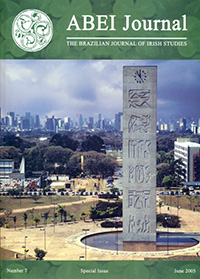Darkness Visible. Insight and Visual Impairment in Brian Friel’s The Enemy Within
DOI:
https://doi.org/10.37389/abei.v7i1.184216Abstract
Considering the development of Brian Friel’s plays since the mid- 60s, one looks back at his first successful play The Enemy Within (1962) with fascination. In retrospection the play is seminal work as it develops the themes of exile, quest, displacement, nostalgia and memory that mark his later production. The Enemy Within is Friel’s first investigation into darkness, as it deals with the prototype of a split character, St. Columba, and the obscurities and shades of a psychic division later expressed in Public/Private Gar in Philadelphia. The purpose of this article is to draw attention to elements of darkness in Friel’s oeuvre and to the unifying motifs of darkness and blindness in The Enemy Within, which characterize the play and make it interesting per se. In fact, in spite of a certain naiveté in structure, The Enemy Within is built around a compact imagery based on polarities and parallelisms, in which darkness, disease and decay are counterbalanced by maybe too overt hints to light, resurrection and rebirth, thus highlighting a variety of “enemies within” to be fathomed and faced.
References
Anderson, Orr Alan, and Anderson, Marjorie Ogilvie, eds. Adomnán’s Life of Columba. Oxford: Clarendon Press, 1991.
Boltwood, Scott. “‘An emperor or something’: Brian Friel’s Columba, Migrancy and Postcolonial Theory”, Irish Studies Review, 10: 1: 51-61.
Corbett, Tony. Brian Friel. Decoding the Language of the Tribe. Dublin: The Liffey Press, 2002.
Delaney, Paul, ed. Brian Friel in Conversation. Ann Arbor: University of Michigan Press, 2000.
Friel, Brian. The Enemy Within 1975. Dublin: Gallery Press, 1979.
____. The Diviner. Dublin: The O’Brien Press; London: Allison and Busby, 1983.
____. Selected Plays. London: Faber, 1984.
____. Dancing at Lughnasa. London: Faber. 1990.
____. Wonderful Tennessee. Dublin: Gallery Press, 1993.
____. Molly Sweeney. Dublin: Gallery Press, 1994.
____. Give Me Your Answer, Do!. Dublin: Gallery Press, 1997.
____. Three Plays After. Faber: London, 2002.
Heaney, Seamus. Door into the Dark. Faber: London, 1969.
Herbert, Máire. Iona, Kells and Derry. The History and Hagiography of the Monastic “Familia” of Columba. Oxford: Clarendon Press, 1988.
Hyde, Douglas. A Literary History of Ireland. London: Ernest Benn, T. Fisher Unwin, 1967 (1899).
Lacey, Brian. Colum Cille and the Columban Tradition. Dublin: For Courts Press, 1997.
Maxwell, D.E.S. A Critical History of Modern Irish Drama. 1891-1980. Cambridge: Cambridge University Press, 1984.
Murray, Christopher, ed. Brian Friel. Essays, Diaries, Interviews: 1964-1999. London: Faber, 1999.
Niel, Ruth. “Disability as Motif and Meaning in Friel’s Drama”. Hungarian Journal of English and American Studies, 5: 1 (1999): 143-59.
O’Brien, George. Brian Friel. Dublin: Gill and Macmillan, 1989.
O’Toole, Fintan. “The Man From God Knows Where”. In: Dublin. 28 October 1982: 20-3.
Pine, Richard. Brian Friel and Contemporary Irish Drama. London: Routledge. 1990.
____. “Love: Brian Friel’s Give Me Your Answer, Do!. Irish University Review, 29: 1 (Spring/Summer 1999): 176-88.
Robbins, Joan. “Conjuring the Life of the Spirit in the Plays of Brian Friel”. The Canadian Journal of Irish Studies 18: 2 (December 1992): 75-87.
Room, Adrian. Dictionary of Place-Names in the British Isles. London: Bloomsbury, 1988.
Szondi, Peter. Theory of the Modern Drama: A Critical Edition. Ed. and trans. Michael Hays. 1956. Cambridge: Polity Press, 1987.
Upton, Carole-Anne. “Visions of the Sightless in Friel’s Molly Sweeney and Synge’s The Well of Saints”. Modern Drama, XL: 3 (Fall 1997), 347-52.
Downloads
Published
Issue
Section
License
Copyright (c) 2005 Giovanna Tallone

This work is licensed under a Creative Commons Attribution-NonCommercial 4.0 International License.


